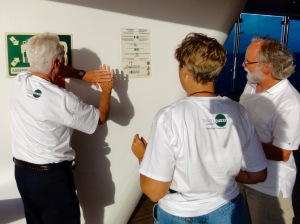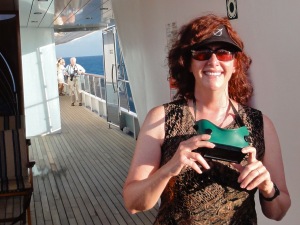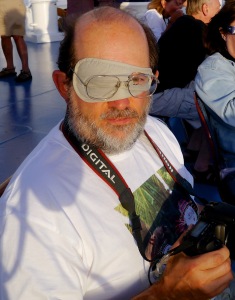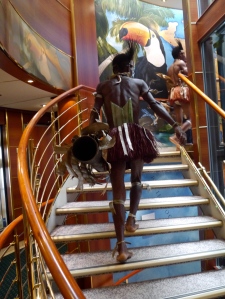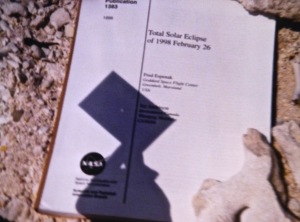Follow this link to hear my very excited and hopeful (and in retrospect, sad) RNZ interview with First Up host Lydia Batham, recorded at sea on the M/S Paul Gauguin after leaving Pitcairn Island.
Tag Archives: Astronomy tour
Hello Darkness, MOF
Prepping again for the next TSE! The welders glasses I’ve used for the partial phases since The Big One (Baja, 1991) are scratched, worn, and a little broken, but they’ll block blinding Sol’s rays one more time with a little duct tape patch on the seam. I hope.
I’m currently overpacking (example: three bathing suits) for the South Pacific “Cruise to Totality”, a TravelQuest tour aboard the MS Paul Gauguin that will sail from Tahiti on June 27. Her passengers will witness 3 minutes and 16 seconds of totality at sea on July 2, 2019, somewhere between Pitcairn Island and Rangiroa. Clear skies are expected, and I’ll have my eighth total solar eclipse in the can.
I’m almost more excited about the add-on excursion to Easter Island (Rapa Nui), a destination I’ve always wanted to see for myself. Something about those massive Moai heads are calling—so much so that I made an effort during a road trip to the Midwest this month to find and take a selfie with the “Moai Dude” sculpture. He stands in a suburban playground in Altoona, Iowa. Can’t wait to meet a real one…next week!
Great Barrier Reef
 Oh, the eclipse? *yawn* Just another breathtaking miracle of nature.
Oh, the eclipse? *yawn* Just another breathtaking miracle of nature.
The sky was blue and the Orion steady on eclipse day, following two grueling days on choppy seas to return to the calm waters over the Great Barrier Reef near Port Douglas.
Jay Anderson—meteorologist, astrophotographer, and co-author of the NASA eclipse bulletins with Fred Espenak—commanded a microphone and walked us through the timeline of events. Meet Jay in this video and hear his play by play (“filters off!” “shadow bands behind you!”). Jay also consulted with the captain and special reef pilot who was brought on board to guide the Orion over the Reef and ensure the best viewing area.
Thanks to his coaching I got my goggles on and off in time to witness all the phenomena. Baily’s beads were meh but we saw the best. diamond. ring. EVER. The prominence flames were higher than I’ve ever seen them too.
At third contact many beers (Corona, natch) were consumed, followed by brunch on deck and a how-was-it-for-you debriefing session in the Leda Lounge for the relieved and excited chasers. Most of them were either first time virgins—virgins no longer!—or had just racked up their 10th or 15th TSE. Me?
Six for six, and counting.
The moments on deck are captured in this 5-minute video. If you’re hoping to see the eclipsed sun itself, lower your expectations: this captures the minutes leading up to totality on deck, and before and after reactions. (Here’s a 3-minute video of totality—again, no sun, but you’ll see the sky go dark and brighten at third contact.
Above: Diamond ring photo via Snapfish, taken from the Paul Gauguin, July 10, 2010
Below:
Scenes on board the Orion, November 13, 2012.
Variety of customized gadgetry, including scope “squint” aids and fancy pinhole projection art.
TravelQuest founder and president Aram Kaprielian. (Is there a bigger smile than the one on the tour director after a cloudless TSE?)
Island hopping
 In 2012, 60,000 people descended on Cairns for the TSE. Ninety of us sailed away for awhile to visit the Papua New Guinea people in their secluded villages.
In 2012, 60,000 people descended on Cairns for the TSE. Ninety of us sailed away for awhile to visit the Papua New Guinea people in their secluded villages.
With expedition natural scientists as our guides we watched locals dig for Megapode eggs, laid in the ash leftover from the still-active Tavurvur volcano eruption.
We were led into remote Watam Village, where there’s no wifi—or roads, or phones, or electricity—by an ostentatious ceremonial dragon dance and witnessed “sing sing” cultural performances at every historic, scenic, mind-blowing location.
We were shown how to make pasty palm sago, the local staple that can baked into a pancake-like bread. We sailed through fjords (not just for Norway anymore) and boarded hand-carved outrigger canoes, paddled by willowy young girls, to get to villages deep in the jungle. We saw flying bat colonies and “yam houses” and masks of human bone. By the way, the people of Papua New Guinea stopped practicing headhunting and cannibalism, oh, gosh, months ago.
My favorite people were the lusty Kitava from the Trobriand Islands. When colonial rulers came to stop the inter-island warring in the 1800s they were aghast to see the suggestive thrusting and pointing during the ceremonial Kitavan dances. The Europeans introduced them to cricket as a means to channel their competitive fighting and ribald desires. Unfazed, the enthusiastic islanders just substituted a violent cricket rivalry—and used their vulgar dances anyway as a victory celebration to taunt the opposing teams.
The Orion also supplied sea kayak and snorkel gear, taught passengers how to use it, and ferried everyone via Zodiac boat to private coves to swim in the reefs and enjoy barbecue lunches on white sandy beaches. “Big Dave”, my new friend on board (and expert diver) taught me to snorkel on Nuratu Island. Underwater it was like an aquarium in a tropical fish store. The hardcore divers on board said it was the best snorkeling they’d ever experienced.
Life on the Orion
 It was a wedding gift of sorts. Two months after we married, Ralph sent me on my own to join another TravelQuest eclipse tour, this time on the glamorous expedition ship Orion. The dream itinerary: a private charter flight from Cairns Australia to Papua New Guinea to join the Orion for nine days—a ship small enough to carry passengers to several remote villages—and a grand finale, totality at the Great Barrier Reef.
It was a wedding gift of sorts. Two months after we married, Ralph sent me on my own to join another TravelQuest eclipse tour, this time on the glamorous expedition ship Orion. The dream itinerary: a private charter flight from Cairns Australia to Papua New Guinea to join the Orion for nine days—a ship small enough to carry passengers to several remote villages—and a grand finale, totality at the Great Barrier Reef.
The intimate Orion (90 passengers, 75 crew) came equipped with kayaks, Zodiac landing craft (many of our ports were “wet landings”), and diving and snorkeling gear. The professional expedition staff included a marine biologist, acclaimed wildlife photographer Sue Flood, a field biologist, meteorologist Jay Anderson, planetary scientist and former NASA astronaut Thomas Jones, and a cultural anthropologist—an Aussie who married into a PNG village and actually became a chief, who knew everyone and all the local customs.
Each day at sea there were workshops and lectures on the flora and fauna of PNG, space travel, photography, and a cultural briefing on the islands we would visit—all accompanied with drinks and traypass hors d’oevres. The food—three squares a day plus high tea and assorted cocktail parties—was exquisitely prepared and, like most cruises, nonstop. I was giddy like a girl asked to the prom when a note addressed to Miss Coleman in Stateroom 310 included an invitation to dine that night at the table of Captain Andrey Domanin, “Master of the Orion”.
One night after dinner the captain took a joy ride past the actively-erupting Manam volcano; red lava flowed down the side and rocks and flames shot out of the top. (As I watched from the deck, a glass of champagne in my hand, I wondered: am I asleep?)
Performers boarded the Orion in our last island port and drummed a farewell before we sailed to the Great Barrier Reef. The last days at sea were rough, literally and figuratively. Barf bags were tucked behind the rail on every deck. The ship’s doctor Doctor Chris administered shots and big blue nausea pills; Dramamine was heaped in a tasteful bowl on the reception counter.
I was one of the few unaffected and had work to do—an article on Burning Man due for Trailer Life magazine. I found an empty bar on the top floor of the ship but my laptop kept sliding off the table what with all the pitching and yawing. (Cruise ship tip: when seas are high, climb down to the level nearest the hull, where it’s calmer.) The dining room was sparsely populated with wan-looking, uncommunicative passengers. The ill-conceived cocktail of the day was banana liqueur and coconut rum—a little warm ginger ale might have been a bigger seller.
(Sound like fun anyway? Get on board for this one: the TravelQuest South Pacific Cruise to totality on the Paul Gauguin with a pre-vacay on Easter Island.)
Above: The Orion
Below:
Commemorative rubber stamps; All aboard; Lounge and meeting room; Stateroom 310; Cairns; Snorkel gear; On deck; From the Zodiak; Manam volcano; What to wear?; Dancers on board; Still waiting for the Green Flash.
Papua New Guinea
The celebration tent
 A giant tapestry-type tent was erected on the beach outside the hotel in Mersa Matruh, and the post-eclipse celebration inside was memorable—woven carpets covered the sand, and table after table was heaped with catered Mediterranean food.
A giant tapestry-type tent was erected on the beach outside the hotel in Mersa Matruh, and the post-eclipse celebration inside was memorable—woven carpets covered the sand, and table after table was heaped with catered Mediterranean food.
Funny WTF moment: at the cheese and hummus table I pointed to a bowl of chalky grey squares and inquired with a lift of my eyebrows to a man behind the table wearing a chef’s uniform and tall white toque. He just shrugged, so I reached for one and started to put it in my mouth. “No eat!! No eat!!” he screamed, waving me off. I dropped it and ran. I still don’t know what it was.
A dorky DJ spun outdated American records and the frenzied eclipse nerds danced to “YMCA”.
The entire glorious day was a travel memory I wish I could relive, with my Ralph, exactly as it was—except I’d take more photos.
Above: Celebration tent in Mersa Matruh
Below:
Fabulous food
Chasers get down
The pink bus
 We joined the TravelQuest tour already in progress at the Meridien Pyramids hotel for the bus excursion to the eclipse site.
We joined the TravelQuest tour already in progress at the Meridien Pyramids hotel for the bus excursion to the eclipse site.
If you’re thinking about traveling to a TSE, I can’t recommend TravelQuest highly enough. I generally hate the term, “trip of a lifetime” (unless you’re 100 years old, never say “never again,” right?) but a TravelQuest astronomical tour is so unique each time, so outrageously special, that you really will refer to it as a once in a lifetime adventure, just like their website says. Founder and President Aram Kaprielian is the most dedicated, detail oriented travel professional I’ve ever met and a man who really shares the joy of the experience with each traveler on the tour.
Even the grating lady—there’s always one—on our “pink” bus, who broadcast her every movement to no one in particular but for all the bus to hear. “I’m getting a coke from the ice chest now.” “I’m going to use the rest room now.” “Oh my, look at that <whatever outside the window>.” There must be a name for this disorder.
Western Egypt is flat and arid and refreshingly devoid of tourists. The bus stopped at the El Alamein WWII museum and cemetery at Mersa Matruh, the site where Rommel’s German Afrika Korps were smacked by the British and the allies.
In the Time Before Ralph (TBR), I was indifferent to ye olden days, but through him I’ve grown to appreciate the past…a little. Traveling with a history teacher is like having a personal docent at every museum, castle, monument and art gallery, and Ralph knows all the dirt about every world leader. It’s enlightening (and sad) to hear about the scandals and deceits and failures of yesterday that continue to repeat today, over and over, exactly as before.
Military museums like El Alamein and this one provide a historical perspective that can deepen your understanding of a place and its people, and they usually exhibit early attempts at technology (and some flat out crazy items) you won’t see anywhere else.
The bus came to rest in Mersa Matruh the night before the eclipse. It felt heavenly to put a beer in my hand and dig my toes in the sand on the private beach outside the hotel.
Above: Everybody on the bus
Below:
Tour group (and swag)
Historian at large
Egypt
Close call
 White puffy clouds filled the blue sky on eclipse day, and we eyed them nervously. The odds of the eclipse being obscured looked higher than 50-50, and prompted much discussion among the organizers.
White puffy clouds filled the blue sky on eclipse day, and we eyed them nervously. The odds of the eclipse being obscured looked higher than 50-50, and prompted much discussion among the organizers.
Ashore, chances for good weather were fair—but if cumulus clouds formed, we were SOL unless it was sufficiently windy. Those on land would at least be ensured a fun day playing on the beach, or we could shop in the clean, touristy, Netherlandic town while we waited for totality.
Option 2: remain aboard the maneuverable ship that could be positioned under a cloudless patch in the sky at 2:09. The downside was a drag, though: no special area was reserved by the tour group—meaning jostling for position with the 2000 non-astronomers also on board—and there would be fewer diversions during the long hours of partiality.
I pitted out over this decision, and in the end Susan and I decided to roll the dice and accept the offer to stake out a section of beach in Oranjestad, Aruba, where we could snorkel DePalm Island. At 7:30 a.m. we waved goodbye to the Fascination, sailing south toward improved chances (and a longer TSE near the centerline).
It was definitely a nail-biter with clouds overhead all day, but the sky cleared beautifully for totality. There were happy smiles all around when the ship docked to pick us up; skies were clear at sea as well.
Above: Ominous clouds (cue the theme from Jaws)
Below:
Welcome to have fun at DePalm Island
Partial viewing
Three for three!










